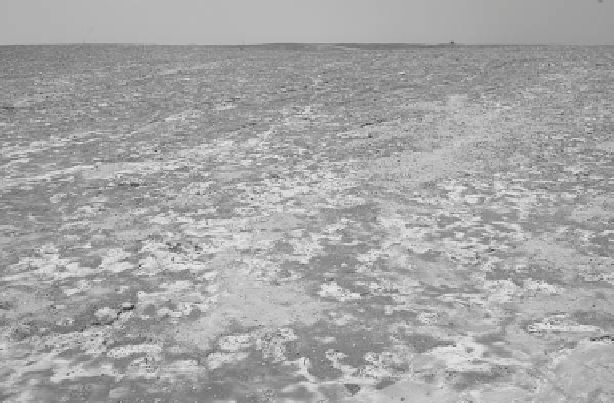Environmental Engineering Reference
In-Depth Information
FIGURE 21.2 (
Continued
)
Resembling snow, extensive surface deposits of salt at the
ancient Mesopotamian city of Mari, located near the Syria-Iraq border.
thresholds and descending more slowly. Similar relationships of yield and productiv-
ity exist for fish species, and it will be necessary to establish these criteria if the goal
of successfully creating and maintaining marsh habitat is to be met.
Leaching and flushing water comprise one effective way to manage salt (Dickey and
Madison 2004). If the water supply quality can be managed, the same threshold goal
can be achieved simply by running more water through the system. But the problem
of course is that more water needs to be available; for example, if the target and inflow
salinity approach one another, it is necessary to use vast amounts of water to maintain
the targets. So the ideal situation occurs with relatively low supply salinity relative to
the goal or the existence of a more tolerant and thus more water-efficient system that
operates along a different flushing curve. Success therefore depends on the applied
water quality and the species salinity tolerance. The water and salt balances need to
be integrated to effectively manage the system to maintain habitat by being a guide
toward various best management practices or strategies. If it is possible to reduce or
eliminate various salt inputs such as those from industry or cities, it then becomes
much easier to manage the entire system. Depending on what targets are set, it may
be possible to flush a large amount of water through the system to create outflows that
are suitable at least for the more tolerant species. This is, of course, dependent on the
goals and amount of available water but does present another opportunity.
On the watershed scale, the strategies for managing salt range from source con-
trols such as reducing consumptive use, fallowing land, changing crops (all designed
to send more freshwater down the system and less up into the atmosphere), or simply
running a less efficient upstream water system which will allow more to flow down-
stream into the marshes and adjourning fields (Dickey and Madison 2004). Other
options include addressing the timing and seasonal release of surface and subsurface

Search WWH ::

Custom Search